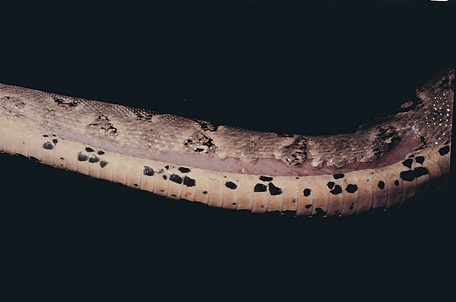This juvenile boa constrictor has been fed live rats that have been kept without food for 6–8 hours (the interval between purchase and when the rodents were offered to the snake). While swallowing one of these rats, the skin of the lateral area of the snake’s neck suddenly ruptured.
| Question | Answer | Article | |
| What is your diagnosis of this condition? | Spontaneous skin rupture, possibly due to hypovitaminosis C. |
Link to Article | |
| Why is it important to know that the prey of this snake have not been fed for several hours? | Under natural conditions, snakes consume prey that have been eating normally; thus, when they consume their prey, the snakes also benefit from the contents of their prey’s alimentary system. Although most snakes synthesise vitamin C in varying amounts, occasionally, these amounts are insufficient to meet a particular snake’s metabolic requirements for this vitamin. In rodents, vitamin C synthesis occurs in the gut; so, if prey rodents have not eaten prior to being fed to snakes, their bodies lack the vital vitamin C-containing ingesta and faeces. |
Link to Article | |
| How would you treat this traumatic skin rupture? | The traumatic laceration must be debrided and sutured, and the snake must be given vitamin C parenterally for several days. |
Link to Article | |
| What measures should be taken to avoid a repetition of this disorder? | If freshly-killed rodents are used as prey, they should be fed a meal prior to being offered to a snake. Alternatively, if frozen and then thawed rodents are used, an appropriate amount of vitamin C in the form of sodium ascorbate can be injected into the rodent carcase, or a portion of a vitamin C tablet can be inserted into the rodent carcase so that it will be absorbed when the snake swallows and digests the meal. |
Link to Article | |
